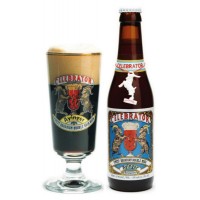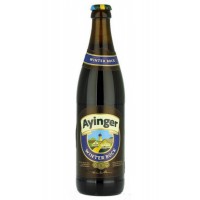Buy Ayinger Celebrator - Ilda’s Santa Hildegarda - Ayinger Winter Bock
Ayinger Celebrator Doppelbock
A beer that has a dominant malty taste. This beer’s origins in a monk’s recipe are reflected in its heartiness. The Pope of Beers, Conrad Seidl, describes it as: “Almost black with a very slight red tone, a sensational, festive foam and truly extraordinary fragrance that at first summons up visions of greaves lard. The first taste is of mild fullness with an accompanying coffee tone, which becomes more dominant with the aftertaste. There is very little of the sweetness that is frequently to be tasted with doppelbock beer.” The Ayinger Celebrator has been ranked among the best beers of the world by the Chicago Testing Institute several times and has won numerous medals.
------------------------------------------------
Lager Doppelbock Bock Tostada. El color es caoba profundo con reflejos rojo rubí. Presenta espuma sólida. Aroma a nuez y un toque de cedro. Notas tostadas. Sabor mucho cuerpo. Tostado, afrutado a malta.
El Beerpope Conrad Seidl, la describe de la siguiente manera: "Casi negro, con tono ligeramente rojizo, una espuma sensacional, sólida y un olor muy raro, que recuerda a la primera manteca.
Celebrator Ayinger se ha clasificado en varias ocasiones por el Instituto de Pruebas de Chicago en el número de las mejores cervezas del mundo y ha ganado numerosas medallas.
Santa Hildegarda
Recibe el nombre de “Winter Beer” o “Cerveza de Navidad” con una producción limitada, se elabora en verano para una guarda y maduración larga y se consuma a partir de Diciembre. Es una cerveza de trago corto para maridar con platos consistentes y continuar disfrutándola al igual que un destilado en la sobremesa.
Variedad elaborada originalmente por los monjes de la región de Munich hace más de 300 años, con esta edición especial y limitada queremos rendir homenaje a la monja Hildegard von Bingen por sus aportaciones en el uso del lúpulo en los procesos de elaboración de la cerveza.
Fase visual: marrón oscuro con espuma blanquecina y cremosa.
Fase aromática: de maltosidad fuerte con aromas tostados y chocolate, con un sútil carácter de ciruela pasa o uva.
Fase gustativa: sabor rico y maltoso, con cuerpo y grado alcohólico pero de entrada agradable, frutos secos (pasas) y tostados, sutil toque de chocolate.
Maridaje: Carnes rojas y de caza, quesos azules, foie gras de pato con cebolla caramelizada, y postres de chocolate.
Ayinger Winter Bock
The recipe for this beer goes right back to monastery traditions. The complex triple mash process using four types of malt gives the dark “doppelbock” its characteristic malty dominance and its close to black color. The storage time of 16 weeks produces a pronounced, well-rounded taste. Despite a high original wort content, the sweetness that is frequently present with doppelbocks can scarcely be detected. The first taste is of mild fullness with an accompanying coffee tone, which becomes more dominant with the aftertaste. Between November and January you can allow yourself to be completely won over by the excellent quality of the Winter Bock.
- Andechs Doppelbock Dunkel - Les Trois Mousquetaires Doppelbock - San Miguel Dorchester
- Franziskaner Premium Weissbier Dunkel - Leffe Blonde
- A. Le Coq Alexander Suur - Sapporo Premium Beer - Caraperro Modern Lager
- Gulden Draak 9000 Quadruple - Whym Loly Pop
- Regional Pilsen - Polar Pilsen - La Chouffe Blonde
- Bavaria 0,0 Wit - Krušovice Černe - Oedipus Gaia
- Oud Beersel Bersalis Tripel - Oud Beersel Oude Geuze (Vieille) - Oud Beersel Oude Kriek Vieille
- Gross Citra Ale - Gross Blackbeard - Gross Galaxy APA
- Negra Modelo - Polar Pilsen
- Caleya Mayuca Amber - Hop Color Vermell - Quer Nelson Sauvin
- Lo Gambusí Cinteta - Orito Baviera de Levante 1927 - Tübinger Pale Ale
- Birreta de lo Secà Red - 84 Brewers Troyano - 7 Vidas American Red
- Heineken 0.0 - Stella Artois - Corona Extra
- Cusqueña Negra Dark Lager - Cusqueña Trigo - Cusqueña Roja
- Flor Entresendas - Les Trois Mousquetaires Kellerbier - Le Trou du Diable Pitoune
- Sacromonte 1598 - Delirium Tremens - Cerex Trujillo
- Ambar Export - Leffe Blonde - Amai Ambar
- Estrella Galicia 1906 Red Vintage - Maisel & Friends Jeff’s Bavarian Ale - Staropramen Premium Lager
- Humulus Lupulus & Keltius Hard as a Hop - Keltius In Peccatum Aisha - Keltius In Peccatum Hidromiel
- Cerveza Zulia - Polar Pilsen
- St. Bernardus Pater 6 - Fantôme Chocolat - De Dolle Oerbier Special Reserva
- Estrella Galicia Cerveza de Bodega - Budweiser
- Argus Tostada - Xibeca - Steinburg Negra Dark
- San Miguel Especial - Mahou Cinco Estrellas - Amstel
- Lost Coast Downtown Brown - Lost Coast Indica IPA - Lost Coast Tangerine Wheat Ale
- Inveb Brahma - Budweiser
- Dos Equis (XX) Lager Especial - Tecate - Heineken 0.0
- Heineken - Quilmes 1890 - Peroni Nastro Azzurro
- Zerep Tostada - Birra & Blues Amber Ale
- Cantillon Fou’ Foune - Cerex Ambroz - Timmermans Framboise Lambicus
- Leffe Blonde - Leffe Brune - Leffe Triple
- La Rulles Triple - Alvinne Omega - Verhaeghe Duchesse de Bourgogne
- Innis & Gunn Rum Finish - Brewdog Jack Hammer - Harviestoun Old Engine Oil
- Victoria - Grupo Modelo - Negra Modelo - Pacífico Clara
- Guineu Sitges - BIIR / Guineu Macchiatto - CerveZahara Rubia de Caí
- Moska d´en SiSet Girona IPA - Beavertown Holy Cowbell India Stout
- Mossa Blonde Ale - Genó La Fresca - Picarda
- Milagritos - Celada Tostada - Bizarra Red Demon Indian Pale Ale
- Bell’s Two Hearted IPA - Founders Lizard of Koz - Founders Mosaic Promise
- Corona Extra - Medalla Light
- Cruzcampo Pilsen - Amstel Radler
- Timmermans Kriek Lambicus - Chimay Bleue / Azul / Blue / Grande Réserve - Gordon Xmas
- BrewDog Albino Squid Assassin - BrewDog Prototype Black IPA - BrewDog Tactical Nuclear Penguin
- Negra Modelo - Bohemia Obscura
- Bidassoa Basque Brewery Mugalari - Bidassoa Basque Brewery La Bronca - Bidassoa Basque Brewery Over The Line! #01
- St. Bernardus Abt 12 - St. Bernardus Wit - St. Bernardus Prior 8
- Harviestoun Ola Dubh 16 Year Special Reserve - Harviestoun IPA - Harviestoun Schiehallion
- Abbaye des Rocs Brune 1979 - Bourgogne Des Flandres Blonde - Abbaye des Rocs La Montagnarde 1979
- Tripel Karmeliet - De la Senne Stouterik - Maredsous Brune / Bruin
- Emperador Ártica Cream Ale - La Primera Rubia - Darwin Sahara
- Dos Equis (XX) Lager Especial - Barrilito - Tecate
- Chimay Red / Rouge / Rood / Première - Delirium Nocturnum
- Estrella Damm - Krombacher Pils Alcoholfrei
- Negra Modelo - Indio - Bohemia
- Son Mayo 15:37 - Son Mucho Trigo - La Axarca
- Te Deum Bruin - Alvinne Mano Negra - Cárdenas Red Ale
- Guinness Foreign Extra Stout - Porterhouse Wrasslers 4X - Metalman Pale Ale
- Barrilito - Corona Extra - Tecate Light
- Berliner Burgerbrau Pils - Dos Equis (XX) Ambar








































































